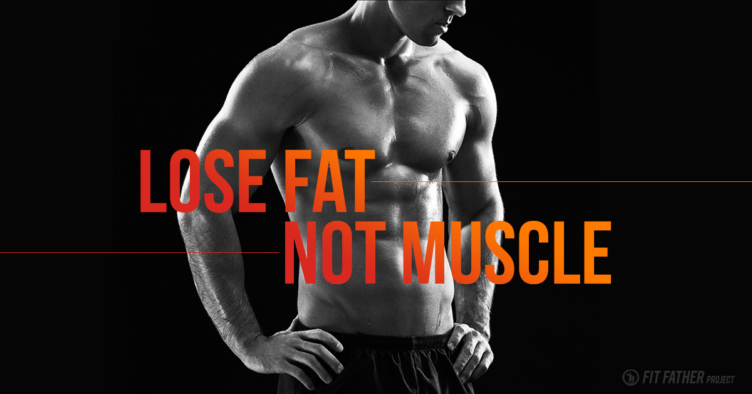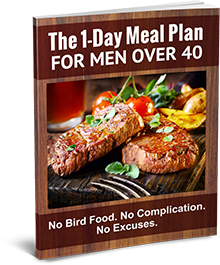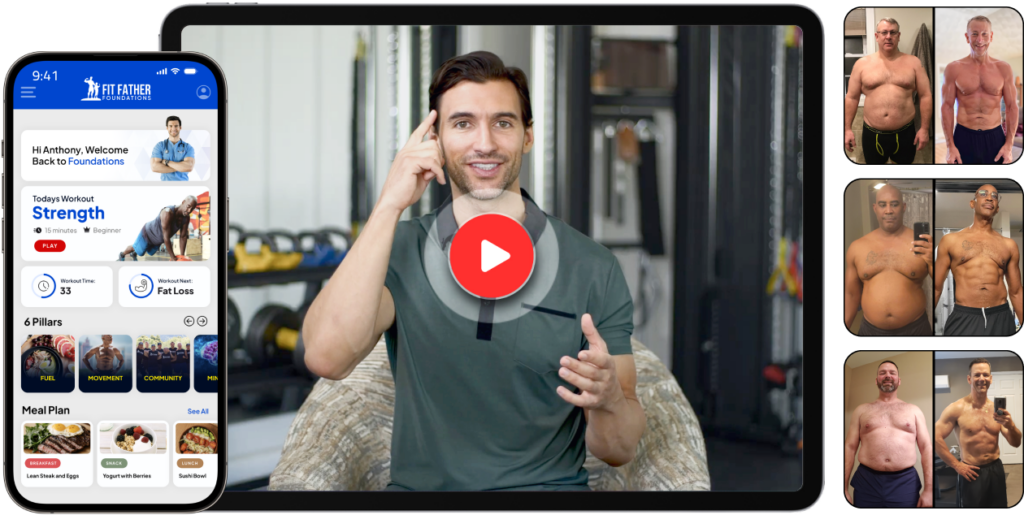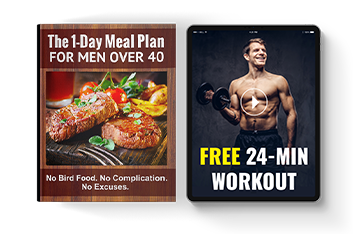It may seem impossible to lose and gain at the same time. But the fact is, you just need the right plan to get you there.
By incorporating the proper balance of diet, exercise, and lifestyle changes you can get that ripped physique by shedding fat and building your muscle mass at the same time.
The Fit Father Project is the perfect place to find the ultimate training programs to lose fat, not muscle.
The team of personal trainers, physicians, and nutritionists use science-backed research to get you the best results possible.
Gain Muscle to Lose Fat
You constantly hear about weight loss in the fitness world. It seems that everywhere you look there is a new fad diet or miracle fat burner that will solve all of your problems.
But the fact is, if you are overweight, your problem isn’t simply that you have too much body fat. It may also be that you have too little muscle mass.
Having a higher percentage of lean body mass is important for so many reasons. For one, it looks good! Ripped, chiseled muscles are a sign of great fitness.
But besides that, lean muscle mass elevates your metabolism and keeps your body burning fat even at rest. Plus, strength training will help preserve muscle even as you lose weight.
Losing fat without losing muscle may not seem possible at first glance. To lose fat, you need your body to be in a calorie deficit. And to gain muscle, you need a calorie surplus, right?
While that is conventional thinking, and largely true, there are ways to lose fat while still maintaining, and even gaining muscle mass.
The Importance of Strength Training to Lose Fat, Not Muscle
One study found that the key to losing fat without losing muscle is the combination of both resistance training and cardiovascular training (1).
When comparing groups that performed either endurance activity versus resistance training versus a combination of both, the combination group was able to lose about 16 pounds of fat while still gaining 10 pounds of muscle!
While this is just one study, the findings make sense. By increasing your calorie burn with endurance exercises, you will lose weight.
And by also incorporating strength training you will be able to maintain muscle mass.
But this is just one piece of the puzzle.
To lose fat without losing muscle, you will need a comprehensive approach that includes not only exercise but diet and lifestyle changes as well.
By committing to these steps, you will be well on your way to achieving these fitness goals.
How To Lose Weight Without Losing Muscle
1) Do Full-Body Resistance Training
In order to build lean body mass, you need to train all of your major muscle groups.
Full-body resistance training is an effective and efficient way to incorporate strength training to achieve the highest results.
Studies have shown that strength training is essential to preserve lean body mass.
For example, one study performed by researchers out of the Obesity Research Center at St Luke's-Roosevelt Hospital, compared participants that were put on a diet plus strength training, diet plus cardio, or diet alone.
Each of these groups lost about the same amount of fat, however, the strength training group lost significantly less muscle mass than the cardio and diet-only groups.
In fact, the diet and cardio groups lost twice as much muscle mass as those that performed strength training.
The strength-training group even showed significant increases in anthropometrically measured flexed arm muscle mass and grip strength! (2)
This shows that all weight loss is not equal! And to keep that toned, muscular physique, strength training is absolutely necessary.
You should aim for a minimum of two days of strength training each week, but preferably three days.
Studies have shown that the most efficient workout plans involve full-body workouts spread out three times a week as compared to only hitting specific muscles once a week (3,4).
If you aren’t sure about what exercises to start with, our free 24-Minute Workout is a great place to start.
Here’s A Free 24-Min Fat Burn Workout For Busy Men 40+
This powerful workout will reignite your metabolism to burn fat 24/7 like you did in your 20s…
Here, you will find some of the top full-body exercises that will show you how to lose fat without losing muscle.
2) Perform High-Intensity Interval Training
HIIT is a great cardio option to burn calories in a short amount of time. But it’s not just a cardiovascular benefit you will be getting.
You can do pretty much any exercise you choose during these intervals.
This gives you the opportunity to train multiple muscle groups so that you will build lean muscle while simultaneously burning off fat.
Research from the University of North Carolina has even shown that HIIT is effective at increasing muscle size over a three week period of time (5).
Along with building strength, this HIIT will also help you burn calories to shed those extra pounds. With higher intensity workouts you will burn more calories, even after the workout has ended.
This is called Excess Post-Exercise Oxygen Consumption, or EPOC for short. So if you are short on time, the key is to really up the intensity.
This ensures that even a workout that is low in minutes will be high in fat burning and strength building.
3) Don’t Cut Calories Too Quickly
So we know that to lose fat, your body has to be in a calorie deficit. And to gain muscle, you need a calorie surplus. It seems like the two can’t happen together.
This is where nutrition and proper dietary planning come into play. If you cut calories to lose weight, it is true that you will lose both fat and muscle.
But if you have a clear-cut dietary plan you can limit muscle loss while still losing fat. And in some cases, still build muscle.
The key here is to first cut calories back slowly. If you are eating 2500 calories a day, don’t suddenly drop down to 1500 calories. This will ensure you lose muscle.
Start with a very small calorie deficit, about 20% of what your intake is currently.
4) Eat A High Protein Diet With Quality Fats
Now that you have cut calories down, the next important step is to figure out where these calories are coming from.
I’m sure you have heard of counting macros, which is breaking down your calories into protein, fat, and carbs. This is essential to do if you want to lose fat without losing muscle.
To lose fat and gain or maintain muscle mass, you need to ensure that you are getting a high proportion of your calories from protein while cutting back on the percentage that is coming from carbs.
Protein is vital in that it not only builds muscle, but it also spares muscle mass while you are cutting calories.
A recent study looked at men on low-calorie diets that were also performing resistance training and high-intensity interval training 6 days a week.
Each group consumed the same number of calories, however, one group consumed a higher protein diet. The higher protein group gained more lean muscle and lost more fat (6).
What is the Right Amount of Protein To Lose Fat, But Maintain Muscle Mass?
The amount of protein you need will vary from person to person. A recent meta-analysis found that muscle-building gains seem to top out at 1.6 grams per kilogram of body weight.
The authors of this analysis also noted, however, that for those looking to maximize muscle-building gains this could be increased all the way up to 2.2 grams per kilogram, or about one gram per pound of body weight (7).
Choose lean protein sources, such as chicken, lean beef, or fish. As far as your other macros go, you need to limit processed foods such as foods high in sugars and simple starches.
These types of foods will spike your insulin levels and lead to increased weight gain.
In order to lose weight and maintain muscle, you also need to limit foods high in saturated and trans fats. This doesn't mean eliminating food groups or “banning” foods from your life.
It means making smart choices on a daily basis to maximize fat loss.
To get you started, check out the free 1-Day Meal Plan from the Fit Father Project. This is a great introduction to help you plan out your nutrition for the day.
Here’s A Free Weight Loss Meal Plan For Busy Men 40+
Discover exactly what to eat for breakfast, lunch, and dinner to lose belly fat & feel energized 24/7 without hard dieting...
5) Eat More Often
Another tip is to increase the frequency of meals throughout the day.
Instead of eating 2 or 3 big meals, try to spread this out into 5 or 6 smaller meals throughout the day.
Research has shown that by doing this you can lose weight while reducing the loss of lean body mass (8).
Spreading out your nutrition throughout the day is especially important for protein intake.
Eating a moderate amount of protein at each meal stimulates muscle protein synthesis more effectively than eating more protein at one meal (9).
6) Get Your Zzzz’s
If your body can’t recover fully, you will never be able to maximize your fat loss and muscle gains. Sleep is just as important as diet and exercise in reaching your full fitness potential.
Sleep deprivation can alter levels in your hormones, like Cortisol, Ghrelin, and Leptin.
These all impact hunger, appetite, and metabolism and, in turn, can have a negative effect on your weight loss goals.
Plus, high cortisol levels will increase fat gain, especially stubborn fat around your belly.
Not getting adequate sleep can limit fat loss even if you are following a proper nutrition and fitness plan (10).
So despite the fact that you are doing everything right with your workouts and nutrition, you can completely sabotage this with poor sleep habits.
Aim for at least 7-8 hours of sleep every night to maximize your ability to lose fat without losing muscle.
7) Decrease Stress
Just like sleep deprivation can alter hormone levels and increase cortisol, so can stress.
This stress hormone can lead to increased appetite and weight gain. Plus, cortisol is a catabolic hormone that can lead to muscle wasting as well.
Stress is a complex issue and one that we all face on a day to day basis. Modalities like meditation, yoga, or just sitting in a quiet room may be able to help you deal with stress.
However, if you feel that you are constantly overwhelmed you should never hesitate to talk with your doctor about your levels of stress.
So if you are committed to a quality diet and exercise program and still not seeing results, do not ignore the stressors in your life.
By managing stress, you can see significant improvements in your ability to lose fat while still maintaining muscle mass.
8) Stay Hydrated
Maintaining proper hydration is a top priority in fitness, especially regarding losing weight while still preserving lean body mass.
Studies have shown that athletes exercising while under-hydrated have a decrease in resistance training performance (11).
If you can’t perform strength training at your highest level, you will be unable to maintain muscle mass while still losing weight.
Staying well hydrated is also crucial for ongoing weight loss. Studies have shown, that when coupled with good nutrition, drinking enough water can increase weight loss.
In addition, drinking more water throughout the day may also decrease hunger cues and help you cut back on calorie intake as well.
The amount of water that you should be drinking each day will vary based on your level of activity. The easiest way to monitor your hydration status is by the color of your urine.
This should be pale or clear colored. And always remember that the higher your level of activity, the more water you will need throughout the day.
Lose Fat and Gain Muscle with the Fit Father Project
Losing fat without losing muscle may seem like a daunting task at first. But by following the right plan, anything is possible.
If you can commit to the steps above, you will be well on your way to shedding those pounds while keeping a muscular, fit physique…
…And the team at the Fit Father Project will be there every step of the way motivating you and holding you accountable to these goals.
There are a number of fitness programs and articles offered by the Fit Father Project that can help you along the way.
But it’s not just about the programs themselves, but about the people that will be there to push you as you work towards your goals.
So start today and transform your body into a healthier, fitter you.
Your new friend & coach,
Holly Smith, M.D., B.S. Dietetics, NASM-PES Certified Trainer
Writer, Fit Father Project
Holly is board-certified in nephrology and internal medicine, has a bachelor’s degree in dietetics, and is a certified personal trainer with NASM-PES certification.
Holly is a keen runner, triathlete, and fitness and nutrition enthusiast. She has completed four full ironmans, twelve marathons, countless half ironmans, Olympic distance triathlons, half marathons, and numerous other road races.
Holly joined the Fit Father Project in May 2019 as a regular writer, contributing articles on health, wellness, exercise, and nutrition.
Join our 6-Week Doctor Designed Health Program. You'll Gain Foundational Health for the Rest of Life.
The FOUNDATIONS Program is created by Dr. Anthony Balduzzi for Men 40+ who want Lifelong Health.
In just 6-Weeks following FOUNDATIONS, you'll experience:
- Rapid decrease in body fat
- Dramatically improved energy levels
- Greater mental sharpness & clarity
- Muscle gains & better cardiovascular fitness
- Decreased inflammation & pain
- Renewed motivation & greater focus on health.
FOUNDATIONS has transformed 60,000 lives! Are you ready to experience true lasting health & results?
- We'll help you drop unhealthy habits forever
- We'll show you the EASIEST way to eat healthy for life.
- You get Doctor-Designed Workouts for Men 40+
- You gain Daily Accountability & support from our team of doctors & certified personal trainers.
*Please know that weight loss results & health changes/improvements vary from individual to individual; you may not achieve similar results. Always consult with your doctor before making health decisions. This is not medical advice – simply very well-researched info on how to lose fat without losing muscle.
References:
1) Wallace, M. B., Mills, B. D., & Browning, C. L. (1997). Effects of cross-training on markers of insulin resistance/hyperinsulinemia. Medicine and science in sports and exercise, 29(9), 1170-1175.
2) Geliebter, A., Maher, M. M., Gerace, L., Gutin, B., Heymsfield, S. B., & Hashim, S. A. (1997). Effects of strength or aerobic training on body composition, resting metabolic rate, and peak oxygen consumption in obese dieting subjects. The American journal of clinical nutrition, 66(3), 557-563.
3) Schoenfeld, B. J., Ratamess, N. A., Peterson, M. D., Contreras, B., & Tiryaki-Sonmez, G. (2015). Influence of resistance training frequency on muscular adaptations in well-trained men. The Journal of Strength & Conditioning Research, 29(7), 1821-1829.
4) Ochi, E., Maruo, M., Tsuchiya, Y., Ishii, N., Miura, K., & Sasaki, K. (2018). Higher training frequency is important for gaining muscular strength under volume-matched training. Frontiers in physiology, 9.
5) Blue, M. N., Smith-Ryan, A. E., Trexler, E. T., & Hirsch, K. R. (2018). The effects of high intensity interval training on muscle size and quality in overweight and obese adults. Journal of science and medicine in sport, 21(2), 207-212.
6) Longland, T. M., Oikawa, S. Y., Mitchell, C. J., Devries, M. C., & Phillips, S. M. (2016). Higher compared with lower dietary protein during an energy deficit combined with intense exercise promotes greater lean mass gain and fat mass loss: a randomized trial. The American journal of clinical nutrition, 103(3), 738-746.
7) Morton, R. W., Murphy, K. T., McKellar, S. R., Schoenfeld, B. J., Henselmans, M., Helms, E., … Phillips, S. M. (2018). A systematic review, meta-analysis and meta-regression of the effect of protein supplementation on resistance training-induced gains in muscle mass and strength in healthy adults. British journal of sports medicine, 52(6), 376–384. doi:10.1136/bjsports-2017-097608
8) Alencar, M. K., Beam, J. R., McCormick, J. J., White, A. C., Salgado, R. M., Kravitz, L. R., … & Ferraro, R. T. (2015). Increased meal frequency attenuates fat-free mass losses and some markers of health status with a portion-controlled weight loss diet. Nutrition research, 35(5), 375-383.
9) Mamerow, M. M., Mettler, J. A., English, K. L., Casperson, S. L., Arentson-Lantz, E., Sheffield-Moore, M., … & Paddon-Jones, D. (2014). Dietary protein distribution positively influences 24-h muscle protein synthesis in healthy adults. The Journal of nutrition, 144(6), 876-880.
10) Nedeltcheva AV, Kilkus JM, Imperial J, Schoeller DA, Penev PD. Insufficient Sleep Undermines Dietary Efforts to Reduce Adiposity. Ann Intern Med. 2010;153:435–441. doi: 10.7326/0003-4819-153-7-201010050-00006
11) Judelson, D. A., Maresh, C. M., Farrell, M. J., Yamamoto, L. M., Armstrong, L. E., Kraemer, W. J., … & Anderson, J. M. (2007). Effect of hydration state on strength, power, and resistance exercise performance. Medicine & Science in Sports & Exercise, 39(10), 1817-1824.





